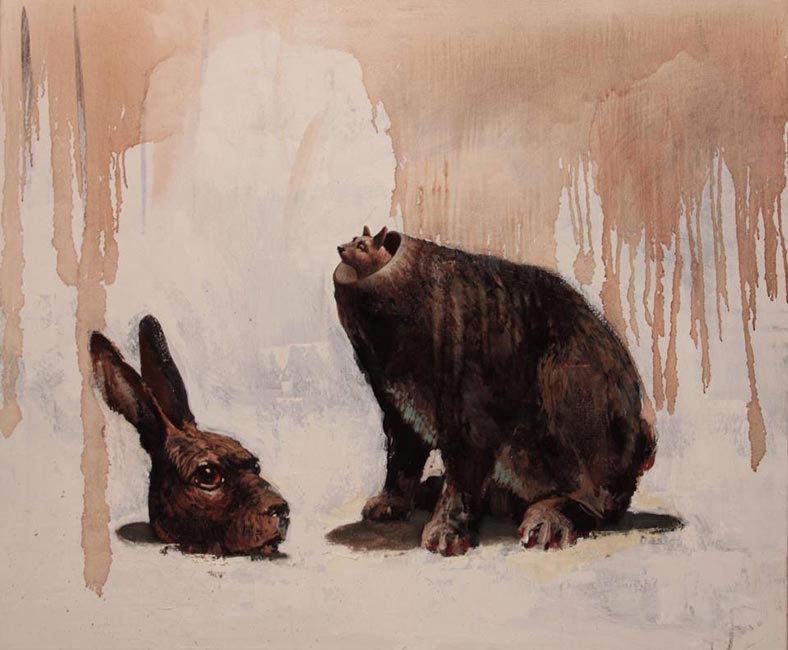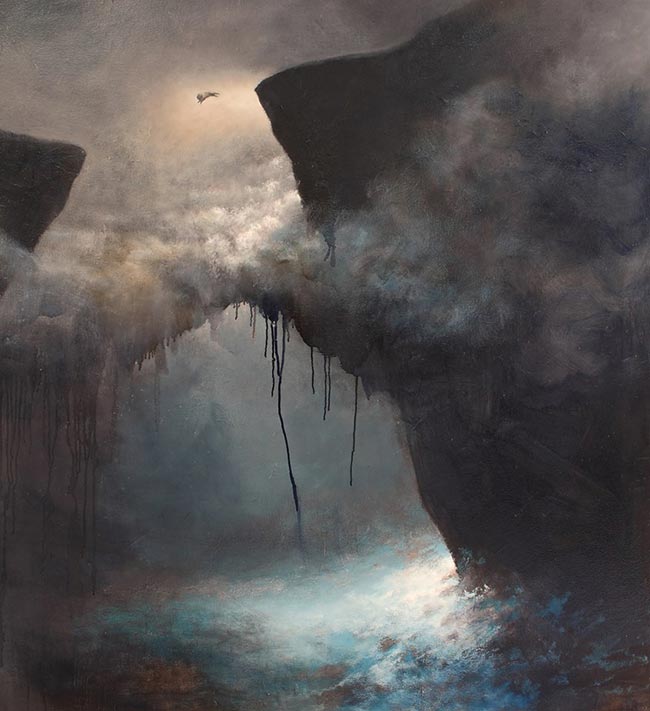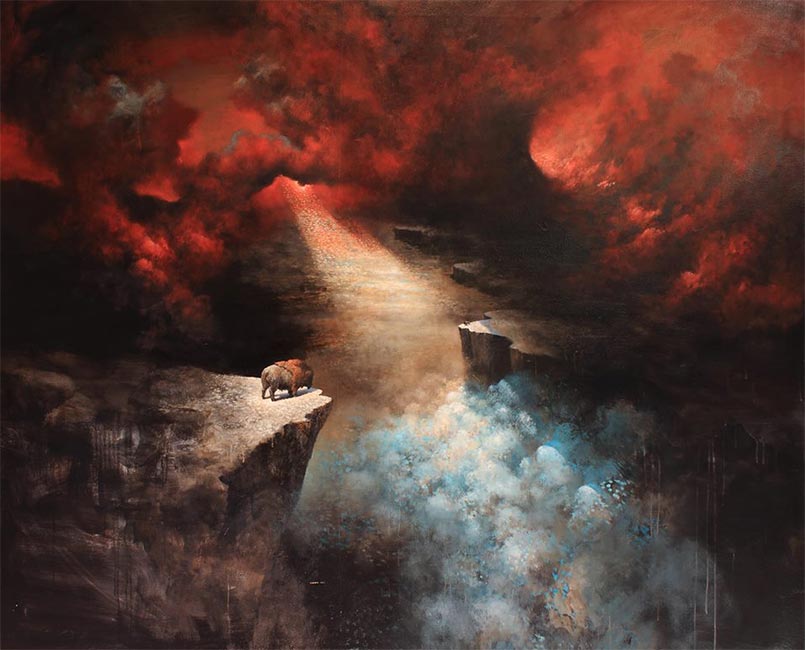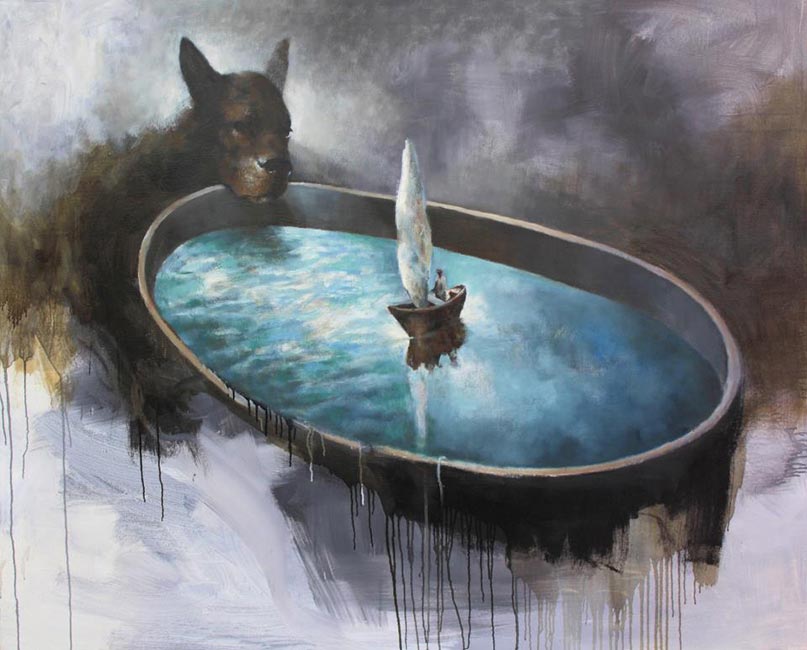Samuli Heimonen is a Finnish artist who creates thought provoking figurative paintings with elements of the surreal and a very strong sense of narrative. Heimonen ponders many of humanity’s larger questions and seeks answers to them within the metaphors which arise during his intuitive painting process. Incoporating his deep love of nature and animals, Samuli constructs dreamlike scenarios filled with a palpable atmosphere and the unusual contrasts of scale, which are so familiar to us all from our own dream worlds. Within these narratives, animals often become a symbolic representation of humanity and human emotion, always portraying our most defining characteristics with a breathtaking honesty.
Samuli was born in Saarijärvi, Finland in 1975, and currently lives and works in the former Kaihlamäki school in Kangasniemi, central Finland. He has earned a name for himself as one of Finland’s most respected artists and his work is to be found in many Museum collections within his home country.
WOW x WOW caught up with Samuli during his preparation of a new body of work for an upcoming solo show in Helsinki. Find out what he had to say in the following interview.
Hi Samuli, thanks for giving us some of your valuable time by agreeing to answer our questions. Firstly, can you tell us a bit about your background and what it was that lead to pursue a career in the arts?
As a child I really wasn’t into art. Painting came much later in my teens. I had a very good friend and we explored the art world together. We started from surrealism and went further into renaissance and symbolism. Without this friend I would never have had the courage to paint. We challenged each other in a friendly spirit. At that time it wasn’t cool to paint or to be interested in art in our school. We were rebellious in our own way.
You have studied at various art institutions over the years. Were there any particular courses, tutors, or words of advice given, that have been especially beneficial and played an important role in forming the artist you are today?
All the first teachers have been very important in good and in bad. When I was starting painting in school, my art teacher encouraged me to continue. That really made a big difference. It wasn’t about advice on technique, it was about somebody believing in me. That was a big thing at that point.
Later in art school the first teacher that opened my eyes about painting and the materials was Tuomo Saali. We made copies of old masters and I learned a lot from that. Artist Kaarina Kaikkonen was a great teacher and her drawing course made a big impact on my painting. The basis of my painting is in black and white drawing and Kaarina’s course helped me to create this very dramatic style.
After school I’ve really tried to forget all the advice of my teachers. Very easily you tend to please your teacher even though he or she is no longer there. All you have to do is to please yourself and find your own path. That sounds easy, but it isn’t.
Please talk us through your creative process?
My process is very intuitive. I paint a lot and try different ideas and angles. The weak ideas don’t survive and strong ones continue to become finished paintings.
I start with black and white acrylic colours. I paint the basic structure with only black and white and when it’s ready enough, I continue with oil. Sometimes the acrylic painting is very visible and sometimes it’s completely covered with oil.
I have at least ten or fifteen unfinished canvases under work at the same time. For me it’s easier to paint when you can shift from one painting to another. Sometimes I paint one painting for a complete day. When the painting is drying, I move to another work. It is a cycle that rotates. You feed the cycle with new ideas and at some point something comes out of the other end.
You use animals in your art as a metaphor for human emotion, and by doing this you succeed in making the emotion more obvious and tangible for the viewer. Can you talk a little about how you approach this side of your work?
As a viewer, I like the uplifting feeling that you get from old church paintings and from older art in general. For me this is the core feeling as a painter. I like to be raised above normal life and I want to raise people above normal routines through my art.
Animals have this very strange ambivalent quality. They are very familiar and they are almost like us, but still, animals are fundamentally different. They can be a threat or they can be cute at the same time.
Most of all animals are always beautiful and perfect and honest. They are like isolated parts of our psyche. They are caricatures. That’s the reason why they are so accurate in portraying us on a symbolic level.
Your work explores the relationship between the visible and invisible. Tell us about some of the invisible realms you find particularly intriguing?
I’m interested in the relations between people and the relations between people and nature. All this is invisible and it needs to be made into visual form. When we make pictures of our questions and ponderings, we understand the world a little better. We need a picture between us and the world. I think of it as a lens that helps us to focus.
Some questions are just too big to handle. If you think about death, which is very real but at the same time very abstract, you need some kind of a tool to handle it. For me painting is that tool. First of all I paint for myself and secondly for everybody else.
The protagonists in your paintings are often eclipsed in size by another element within the composition, giving the feeling that they dwarfed by an insurmountable obstacle or force. What do these larger elements mean to you and do they represent something negative?
These obstacles never portray anything negative. They might conjure up a somewhat threatening feeling, but at the same time they are intriguing and mesmerising. In my paintings people are usually on the verge of solving a big secret. But there are limits to what we can grasp. And when the limit comes close, these strange metaphors start to rise. We have to build the picture of the unknown with familiar materials. The interesting part is the relations between the materials. In this way my work comes very close to surrealism, but unlike the surrealists my reference is not Freud, it’s Jung.
Aside from being inspired by the human condition, what would you say are some of your other most valued sources of inspiration?
My main inspiration is music. I don’t want to make pictures straight from music but instead I want to surround myself with music and paint a certain atmosphere. Music takes you to places and makes you feel things. It awakens something inside of me. Music is about orientation, inspiration, guidance and escaping daily routines.
I don’t know if the music shows in my pictures, but it’s not important in that way. It’s fuel for painting and it’s the cheapest and fastest way to shut the rest of the world away.
Dreams are also a very dear inspiration for me. I seldom create pictures straight from dreams. I’m interested in the language of dreams. That’s a pure and honest poetic language. It’s rich with metaphors and it lacks all reason. The most important thing is that dreams are very personal, but there are still elements that you can share with others.
In your artist statement you make reference to a ‘primal image’. Can you expand on what this term means to you and how you approach revealing it through your art?
I have noticed that many of my pictures come down to a certain feeling or drama. It’s about scale and it’s about contrast. It’s like an image that you have seen in your dreams. You know how it feels and what it sounds like. You know how it tastes and what it smells like, but you still don’t know what it looks like exactly. Close, but still far away.
As both a painter and a musician, how do the two artistic outlets come together for you?
I’m not a professional musician. I just play for my own pleasure. Playing guitar is very valuable to me. It’s organising things in my head. The similarity with painting is that you see/hear your ideas immediately.
When you play something, you can repeat it endlessly. I really like that. Sometimes that happens with painting also. You have to repeat some pattern within a big canvas. There is some kind therapeutic aspect to it. Making something with your hands organises something in your head.
Your art appears to originate from a very philosophical and questioning state of mind. Is philosophy something you spend your time reading or thinking about or do you prefer to set your own questions to ponder over?
I like to set my own questions, or at least ask them in my own words. The power of art is in transforming very personal and subjective ideas into something common and universal. It’s always surprising how that transition happens.
Sometimes I think that nobody gets a paintings idea, and then suddenly the majority of viewers connect with the picture on a very personal level. My idea is just one story among others.
Salvador Dali and Surrealism were early inspirations for you. What is your relationship with the rest of art history and do you feel that as a painter it is important to understand what has gone before you?
In my opinion it’s crucial to know art history. For me art history is a world of inspiration and orientation. I try to look at things as if looking at them for the first time. I try to enjoy them like they were made yesterday. It’s not important to know exact dates or years. The main idea is to learn from other painters as their colleague, not as an art student.
Painting has to have a strong connection to everyday life and times. I don’t like paintings that only operate by referring to art history. References to art history are just one part of painting. It can deepen the painting when it’s done the right way.
What do you regard as the biggest challenge you face as a professional artist?
It is always challenging enough just to keep up with my own ideas. I try to paint “better” every time.
At this moment I’m creating new paintings for my solo show in Helsinki. Strangely I’ve started to paint as I never have before. These new ideas require a different type of painting. It’s like starting to paint for the first time again.
The most important thing is to keep motivated. After numerous exhibitions the years tend to be the same. For me the whole point is to get excited and elevated. You feel more alive when you have something to die for.
What’s next for Samuli Heimonen?
Exhibitions and exhibitions. Most of them will be here in Finland but I’m hoping that some of them will be abroad also.
I have a new dog, Mörkö (the Groke), a Swiss White Shepherd. It’s my studio dog and my muse. I’m really looking forward to training and working with him.























